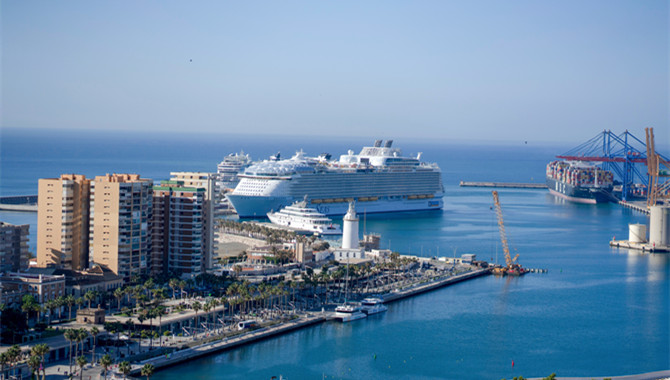Cruise ships are getting ever bigger in size and are often described as being floating cities. For example, Royal Caribbean’s ‘Wonder of the Seas’, currently the largest operational cruise vessel, caters to 7000 passengers in addition to its substantial complement of crew. Managing the waste generated by this number of people in a way that complies with all the regulations is a major challenge.
Cruise ships, let’s face it, represent a considerable risk to environmental cleanliness. Because of the nature of their business, they sail in often pristine and protected waters, they frequently visit busy tourist ports, and because they are larger than ever and carry huge numbers of passengers, they generate tons and tons of waste of all kinds. This all adds up the environmental risk to the air, water, fragile habitats, coastal communities and marine ecosystem. In fact, it has been estimated that cruise ships account for some 77 percent of global marine pollution.
In other words, cruise ships are visiting the most exotic and unspoiled areas of the world, and bringing with them the risk of significant environmental pollution. It’s a conundrum, because the cruise ship sector’s essential marketing strategy is to promote visits to some of the world’s most beautiful places, yet the ships’ presence in those places brings a serious potential for damaging that beauty. There exists a very real link between the industry’s success, and the environmental performance and compliance of the vessels themselves.
The waste streams
The waste streams from cruise ships include bilge water, which may contain oil, grease and other contaminants, sewage, grey water from showers, sinks, laundries and kitchens, ballast water, and solid waste such as food waste and garbage. The U.S. Environmental Protection Agency (EPA) has estimated that a 3000 passenger cruise ship can, in just one week, produce almost 800,000 litres of sewage, almost 4000 million litres of grey water, 95,000 litres of oily bilge water, 8 tons of solid waste, and 568 litres of hazardous waste. Bear in mind that cruise ships are getting ever larger, and today a 3000 passenger capacity is only an average sized vessel.
In addition to all this, there are the air emissions from the ships’ engines. To combat this, many vessels employ scrubber systems to clean the exhaust. However, in the case of open-loop scrubber systems, the wash water containing toxic by-products can be dumped into the sea. Yet another source of sea pollution.
The regulatory environment
There are multiple regulatory authorities involved in attempting to mitigate the problem of waste handling at sea. There is of course the International Maritime Organization (IMO), but also the U.S. Coast Guard, Environmental Protection Agencies, as well as the laws and regulations of the ships’ registered countries that need to be complied with. Special restrictions also apply to certain areas considered to be particularly vulnerable. These include the Mediterranean Sea, the Baltic Sea, the Black Sea, the Red Sea, the Gulfs, the North Sea, the Caribbean Sea and Antarctica.
There have been numerous cases of cruise companies being fined large sums of money for illegally dumping or handling waste. While some cases may have been the result of negligence or intention, this tends to suggest that operators are not always aware of what rules apply to where they are sailing.
Unfortunately, the more complex the regulatory scene becomes, the more difficult it is to remain compliant. Both the industry guidelines, as well as the relevant laws, need to be followed. Furthermore, port states have the authority to inspect and hold accountable any vessels that do not comply. The IMO also requires ships to have a Garbage Management Plan, specifying procedures for minimizing, collecting, storing, processing and disposing of garbage.
Keeping track the easy way
Illegal discharges or prohibited presence in restricted zones are common errors that have the potential to result in heavy fines, hard-to-rectify damage to the company’s image, as well as devastating environmental implications. Tracking and abiding by the vast array of rules and regulations to be faced requires a rapid understanding and awareness of exactly what those rules and regulations are, especially in relation to the ship’s location at any given time. Precise situational awareness is essential.
Without clear guidance, the crew may not be aware of when company policies, or international restrictions, should come into effect and how they should go about applying them. Position-based information avoids ship crews having to remember when and where policies and regulations take effect, thus enabling compliance plans to be made in advance.
OneOcean’s Environmental tool –
EnviroManager presents an easy way to keep track of everything vessels need to know in order to be compliant. This simple, user-friendly solution provides users onboard and ashore with an ‘at a glance’ view on the waste streams in force and any restrictions that may be in place, anywhere around the world. Each waste stream quick view is linked to the regulatory documentation for a granular outlook. Its data base, which is constantly being verified and updated, covers more than 500 environmental zones and 170 nations.
Faulty discharges and the commercial repercussions that follow can be avoided.
EnviroManager provides end-to-end clarity on all environmental requirements, enabling cruise companies to plan a fully compliant voyage, and to enhance the ‘green’ image they wish to promote.
Source: OneOcean
The opinions expressed herein are the author's and not necessarily those of The Xinde Marine News.
Please Contact Us at:
media@xindemarine.com


 Ningbo Containerized Freight Index Weekly Commentar
Ningbo Containerized Freight Index Weekly Commentar  Ningbo Containerized Freight Index Weekly Commentar
Ningbo Containerized Freight Index Weekly Commentar  Ningbo Containerized Freight Index Weekly Commentar
Ningbo Containerized Freight Index Weekly Commentar  BIMCO Shipping Number of the Week: Bulker newbuildi
BIMCO Shipping Number of the Week: Bulker newbuildi  Ningbo Containerized Freight Index Weekly Commentar
Ningbo Containerized Freight Index Weekly Commentar  Ningbo Containerized Freight Index Weekly Commentar
Ningbo Containerized Freight Index Weekly Commentar